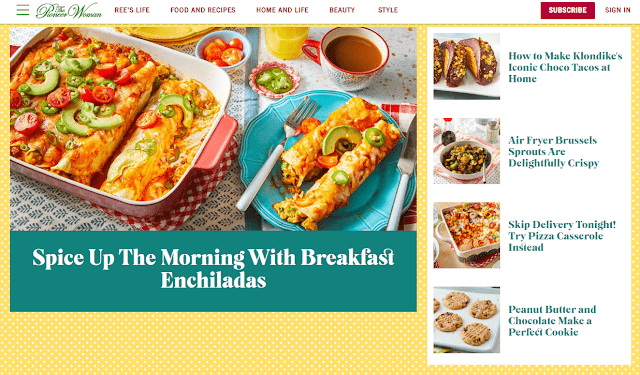What is a Blog? Examples and Types of Successful Blogs
Learn about the different types of blogs, including personal and informational, with examples of successful blogs like Dooce and Gizmodo. Discover the key elements of a successful blog and get tips for starting your own blog.
As the internet continues to grow, so does the popularity of blogging. Blogs have become a powerful tool for sharing information, connecting with others, and even making money. But what exactly is a blog and what are some examples of successful blogs? In this article, we'll explore the world of blogging and provide some examples of successful blogs.
What is a Blog?
Simply put, a blog is a type of website or online platform where an individual or group of individuals regularly share their thoughts, opinions, and experiences on a particular topic. Blogs typically feature articles or posts that are organized in reverse chronological order, with the most recent post appearing first.
Blogs can cover a wide range of topics, from personal experiences and hobbies to news, politics, and business. They can also vary in style and tone, from serious and informative to humorous and lighthearted.
One of the defining features of a blog is interactivity. Unlike traditional websites, blogs allow readers to leave comments and engage in discussions with the author and other readers. This creates a sense of community and helps to build a loyal following.
Examples of Successful Blogs
There are countless successful blogs on the internet, covering a wide range of topics and niches. Here are just a few examples:
- The Pioneer Woman - This blog, created by Ree Drummond, began as a way to document her life on a ranch in Oklahoma. Today, it has grown into a multimedia empire, featuring recipes, home and garden tips, and a popular cooking show on the Food Network.
- The Huffington Post - Started in 2005 by Arianna Huffington, The Huffington Post quickly became one of the most popular news and opinion sites on the web. Today, it covers a wide range of topics, from politics and business to entertainment and lifestyle.
- Lifehacker - This blog, created by Gina Trapani, is focused on providing tips and tricks for making life easier and more efficient. It covers topics such as productivity, technology, and personal finance.
- Mashable - This blog, founded by Pete Cashmore, is dedicated to covering the latest news and trends in social media, technology, and entertainment. It has become one of the most popular blogs on the web, with millions of readers around the world.
- Zen Habits - Created by Leo Babauta, Zen Habits is focused on providing practical tips and advice for living a more mindful and intentional life. It covers topics such as mindfulness, simplicity, and personal development.
These are just a few examples of successful blogs, but there are countless others out there. The key to creating a successful blog is to find a niche that you are passionate about and to consistently provide valuable content that resonates with your audience.
When it comes to starting your own blog, it's important to understand the different types of blogs that are out there. Some blogs are personal, focusing on the author's experiences and thoughts, while others are more informational, providing readers with tips, advice, and news on a particular topic.
Personal blogs can be a great way to express yourself and connect with others who share similar experiences and interests. They can cover a wide range of topics, from travel and food to parenting and politics. One example of a successful personal blog is Dooce, created by Heather B. Armstrong. Dooce began as a way for Heather to share her experiences as a new mother, but it quickly grew into a popular blog that covers a wide range of topics, including mental health, relationships, and social justice issues.
Read more: the journey to success as travel Blogger icon
Informational blogs, on the other hand, are focused on providing readers with valuable information on a particular topic. These can include how-to guides, news and analysis, and product reviews. Some popular examples of informational blogs include Gizmodo, which covers technology news and reviews, and The Spruce, which provides readers with home and garden tips and DIY projects.
No matter what type of blog you decide to create, there are a few key elements that all successful blogs have in common. These include:
- Valuable content - Your blog should provide readers with information, entertainment, or inspiration that they can't find elsewhere.
- Consistency - Consistently publishing new content is key to keeping your readers engaged and attracting new ones.
- Engaging visuals - Adding images and videos to your blog posts can help to break up long blocks of text and keep readers engaged.
- Interactivity - Encouraging readers to leave comments and engage in discussions can help to build a sense of community and loyalty.
- Promotion - Promoting your blog through social media and other channels can help to attract new readers and grow your following.
- also read: 7 examples of successful blog posts
Starting a blog can be a rewarding and fulfilling experience, but it's important to be patient and persistent. It takes time to build a following and establish yourself as a trusted source of information or entertainment. With hard work and dedication, however, you can create a blog that stands out from the crowd and attracts a loyal audience.
In conclusion, a blog is a type of website or online platform where individuals can share their thoughts, opinions, and experiences on a particular topic. Successful blogs are characterized by interactivity, valuable content, and a strong sense of community. By studying examples of successful blogs and finding your own unique niche, you can create a blog that stands out from the competition and attracts a loyal following.






Post a Comment for "What is a Blog? Examples and Types of Successful Blogs"